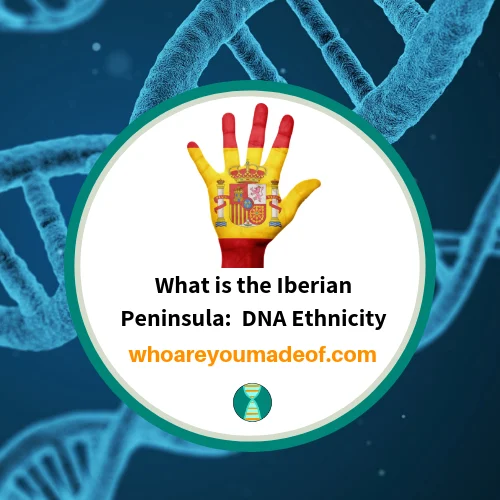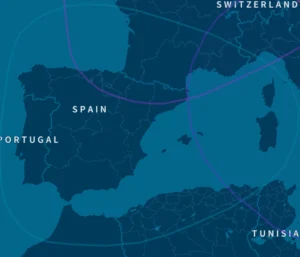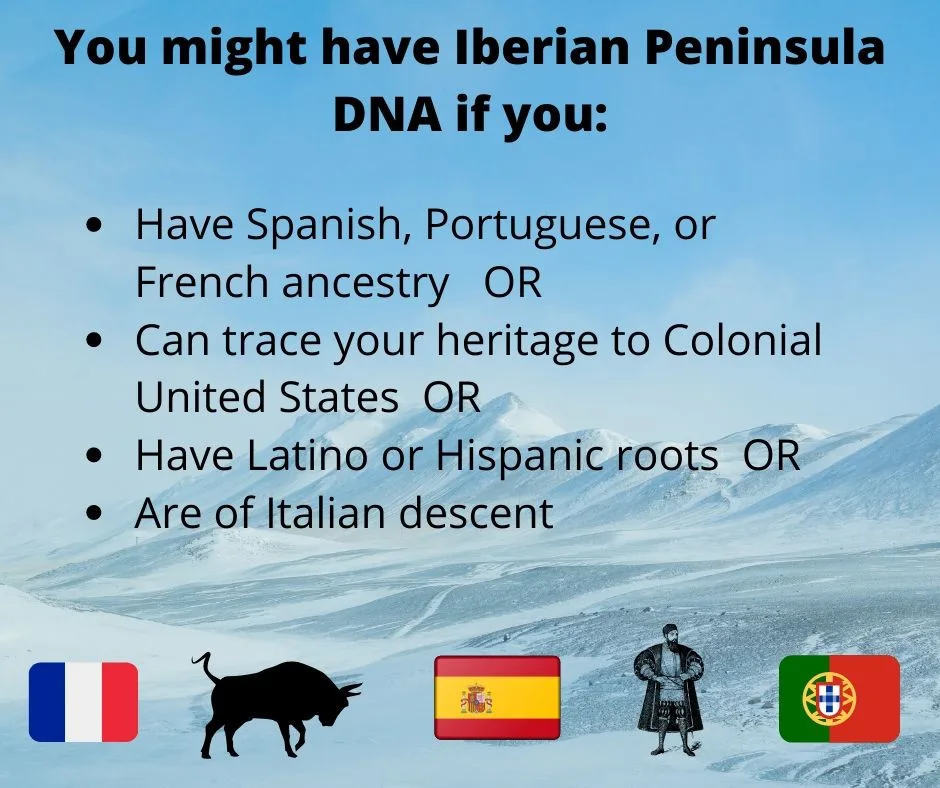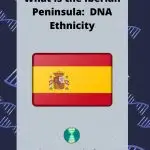A very common question when people see their DNA results is: "What is the Iberian Peninsula DNA ethnicity?" In this post, learn how to how to understand this region and find out why you might have it in your DNA.
Many people who take autosomal DNA tests, such as the ones offered by MyHeritage DNA or Family Tree DNA, are surprised to see Iberia in their ethnicity estimate or ancestry report. In addition, even AncestryDNA previously reported this region on results.
If you have recently discovered that you have Iberian Peninsula ancestry, you have come to the right place.
In this article, I will show you:
- The location of the Iberian Peninsula
- What Iberian Peninsula DNA is
- How Iberian DNA might have ended up in your results
- Whether or not you might be able to find the ancestor(s) who contributed Iberian DNA to you

The Iberian Peninsula has turned out to be one of the most mysterious European DNA ethnicities. Over the years, it has been one of the most popular topics on this site, and I have received more e-mail questions about Iberian ancestry than I do any other region in the world.
Many DNA testing companies are now able to distinguish sub-regions in the Iberian category. Originally, many of us received simply "Iberian" or "Iberia" on our ethnicity results.
Since the original publication of this post, companies such as Ancestry DNA has added more specific regions for the Iberian Peninsula. People who previously saw Iberian in their DNA results might find that it has been replaced with Basque, France, Portugal, or Spain.
Still others might have seen their Iberian disappear completely only to be replaced by a seemingly unrelated region. This has occurred in the ethnicity estimates of many people with Colonial US ancestry.
Where is the Iberian Peninsula DNA region located?
This basic geography question is an easy one. The Iberian Peninsula is located on the southwestern part of the continent of Europe - almost like a little tip - and it is where Portugal and Spain are located.
Here's a fun fact: The Iberian Peninsula, also known as Iberia, is named after an ancient people who the Greeks named "Iberians".
It is important to note that Iberian Peninsula DNA ethnicity is very commonly found in people who live in areas that are not located directly on the peninsula. Keep reading to find out where people who have Iberian DNA can be found.
So What is Iberian Peninsula DNA?
"I don't have any Spanish or Portuguese ancestors," you say. Maybe you do, maybe you don't. More importantly, you should know that it is not only people who live in Spain and Portugal that identify genetically with the Iberian People on the peninsula.
It turns out that people in a large geographic area have "Iberian" DNA. According to Ancestry DNA's reference population, you can find high levels of Iberian DNA in an area as large as the one shown below:

The area that fell within the previous Iberian Peninsula DNA region on Ancestry is shown within the "light blue" circle in the graphic. This means that people who live in Portugal, Spain, France, Morocco, Italy, and Algeria can, and usually do, show strong genetic links to the Iberian Peninsula.
How did the original Iberian DNA spread to cover a section as big as the one in the image? It's easy to imagine that people used to be more stationary in the past, staying close to their local communities and never moving their families to other areas.
In reality, even though people didn't have cars, airplanes, and public transportation, they still found means and methods to travel, even during the Middle Ages. People traveled for business and even pleasure, and others found themselves living in new areas after war, famine, or even marriage.
People who are native to the Iberian Peninsula DNA region are generally very admixed as well, showing only about 51% Iberian DNA, on average. A person from this region is likely to have DNA from Europe South, Great, Britain, Ireland, North Africa and Europe West, along with others.
Why Is there Iberian Peninsula DNA in Other Parts of Europe?
It's easy to understand why someone in France or Morocco is likely to have Iberian Peninsula DNA, but what about those of us who don't have any known ancestors in the nearby region? How did people who don't have heritage from Iberia get Iberian DNA results?
It's very common to find Iberian Peninsula DNA in Western Europe, Ireland, and Great Britain, too.
Some select details (not a complete list!) about the percentage of natives of European regions who show Iberian Peninsula DNA, according to data from Ancestry DNA prior to previous ethnicity updates:
- 20% of people in Western Europe may show Iberian DNA
- 15% of people from Great Britain may show Iberian DNA
- 8% of people from Eastern Europe may show Iberian DNA
Iberian Peninsula DNA can be found in varying degrees all over Europe. The reasons behind why Iberian Peninsula DNA spread beyond the mountainous and relatively isolated peninsula is due to politics, trade, and migration - a very typical human story.
Because of all of the political and merchant connections between Spain/Portugal and other European and North African populations, you can find high percentages of Iberian DNA as far north as Ireland and as far south as Algeria.
How did I get Iberian Peninsula in my DNA Results?
There are many, many answers to this question. That said, here are a few of the major groups of people who live in the US who are likely to have Iberian Peninsula ethnicity show up in their Ancestry DNA test:
- Test takers with at least one Italian grandparent (or even one great-grandparent who is Italian)
- Those who are from a Latin American country, like Mexico, or have a parent or grandparent who is.
- Those who have many British or Irish ancestors, even if they are very distant (i.e. those with strong colonial ties because of what genealogists call endogamy - basically tons of people descended from relatively small, isolated populations - just like the origins of the modern U.S.)
If it isn't obvious by reading that short list, I'll say it: There are a LOT of people in the US with Iberian Peninsula DNA.

What does this all really mean for my Iberian DNA Results?
What having Iberian ethnicity in DNA really means is going to be different for everyone. For some (like me) my Iberian DNA might come from 300-500 years ago, via my colonial ancestors on both sides of the family.
There are thousands of possible ancestors that far back, and it is almost impossible to know who they all were. And that is not including non-paternal events (occasions where paternity is mistaken or hidden).
I was very curious to know why exactly so many people who have ancestors from the British Isles are descended from people from the Iberian Peninsula.
It turns out that there are several theories on why this could be - and possibly, there is more than one explanation. Basically, there has always been contact, such as war and commerce, between European regions.
Additionally, some scientists believe that the islands that now make up Ireland, Scotland, Wales, and England were actually originally populated by Iberians, the original inhabitants of the Iberian Peninsula (though ancient peoples are unlikely to be the source of your Iberian DNA).
Can I Trace My Iberian Ancestry?
Most people are very curious about whether they will be able to find out exactly how they inherited their Iberian Peninsula DNA. It's common to wonder whether a relatively high amount, like over 20%, means that you have an Iberian grandparent, or whether a 6% Iberian Peninsula result means that there was a single Iberian ancestor 5-7 generations ago.
It should be noted that having a low or high percentage of Iberian ancestry is not proof positive of a recent or distant Iberian ancestor.
For some, finding the ancestor who gave you your Iberian DNA might be easier, especially if it occurred within the past 100 years. The only way to really know which is the case for you is to start building your tree (I like using Ancestry for this) and see where your paper trail leads you.
Using your DNA results as a guide is an extra bonus! If you suspect that you have recent Iberian ancestry, then you should find DNA matches at the 4th cousin level or closer who show ancestry in an Iberian country.
If you see a small amount of Iberian Peninsula, and you aren't Latino/Hispanic or Italian, as well, your Iberian DNA might just be from several very, very distant ancestors who migrated between the regions at some point in history.
You could have even inherited very small amounts from more than a few lines of your family tree, making it look like your Iberian DNA is more recent than it actually is. That said, it is theoretically possible to trace your family back that far, especially if you are lucky and very patient.
If you are Latino/Hispanic or Italian/French, you might be able to track down those ancestors who left their Iberian DNA to you. Fortunately, the Catholic Church has kept excellent records over the past several centuries, and that makes your success more likely.
This is because the Catholic Church was extremely influential in most Latin American countries, as well as France, Spain, and Portugal. This means there is a good chance that you will be able to trace your family tree - with some elbow grease - back to your Iberian ancestor.
How to Research My Iberian Ancestry?
If you are new to family tree research, the best place to start working on your tree is by looking through US Federal Census records in order to locate your grandparents and/or great-grandparents.
I like to use Ancestry for building my tree because it is easy to add people and records to the tree, and I can easily share the tree with family or friends or even export it so I can send it as a file to someone.
To see if you can locate your ancestors on US Federal Census records, the best place to start is Ancestry.
Even though it is free to create an Ancestry account and build a tree, you'll need a subscription to view records and documents, but it's easy to add information from those documents automatically to your family tree.
The US Federal Census was done every ten years beginning in 1790, but the census records that provide the most detailed information are from 1860 and more recent. I recommend checking all of the census records from 1860 to 1940 in order to make sure that you learn as much as you can about your family.
Open up the census page, don't just look at the summary that Ancestry gives you. You'll find so much more there when you do, like the month of an ancestor's birth, their occupation, year of arrival, and whether or not they were naturalized US citizens.
After you've exhausted the census records, you will find that you have built yourself a nice little tree, and you should try to collect information on everyone in your tree, including marriage, birth, and death records from those individuals.
At this point, you will know who your immigrant ancestors are, and possibly where they came from. This is the first thing you need to know to accurate figure out where your Iberian might have come from.
For next steps, I would encourage you to read this post that gives more information on how to find family records.
Conclusion
I hope that this article helped you understand a little bit about the Iberian Peninsula, and how it ended up in your DNA ethnicity estimates. Do you have Iberian Peninsula DNA in your results? What percentage do you have? Do you have any ideas about where it came from?
I'd love to hear your thoughts and comments!
P.S. Don't forget to check out my DNA Tools page where I have lots of information about how to understand DNA results, ethnicity regions, and how to find records to help you build your family tree. Check it out: DNA Tools Page
***
If you are interested in understanding more about your DNA results, and specifically your ethnicity, you might be interested in this post about understanding your DNA results. I also wrote a more in-depth post about how DNA tests can tell your ethnicities, and you can access it here.
If you are interested in learning more detail about the Iberian Peninsula people and ethnicity, you might be interest in this post.



Janice
Thursday 25th of January 2024
My siblings and I have the same parents who remained together till dad passed. Yet, we all received different DNA results. How is this possible? My older sister, the firstborn, is the only one with the Iberian DNA. Our ancestors fought in the Revolutionary War. I'm 56% English, mom is 75% English, older sister is 94% English. Younger brother has a high percentage of English but doesn't recall the exact number. I don't get it. Wish we had dad's DNA.
Tamasene bray
Saturday 28th of October 2023
Hi. I thought I was Welsh, I was born and bred in Wales. I'm 60.9% north Wales, 27% Iberian and 10.1% Scandinavian. Don't know of any foreign family. Saying that, we have a lot of "secrets" in our family. Great grans who are actually great aunties etc.
Alicia
Wednesday 5th of July 2023
I'm 70.5% of Iberian Peninsula but being Spanish, it was not a surprise to me. The thing I don't understand is why they say that there is a low confidence in my two genetic groups which are: 1)Southern Spain, France and Algeria and 2) Spain. Then 70.5% Iberian but low confidence in the two areas? I'm confused!
My results: EUROPE Iberian 70.5% Southern Spain, France and Algeria Spain North and West European 19.8% Italian 9.7%
David
Thursday 8th of December 2022
Hi, Irish with 4% Iberian peninsula. Have gone back 7 generations in family tree but nothing found yet.
Cindy
Saturday 12th of February 2022
This article helped me so much. My grandson's biological mother is very dark-skinned and was told her whole life she was part Native American. She finally did a dna test as she wanted to see which tribe. It turned out she was 44% Iberian peninsula. I do genealogical research, so when I did her family tree, her mom's side of the family (dark also) goes back to southern Maryland and were all Irish Catholic! So now I have hope of finding the Iberian connection, right? If I can access Catholic records? So how does one do that? Just continue on ancestry and family search?